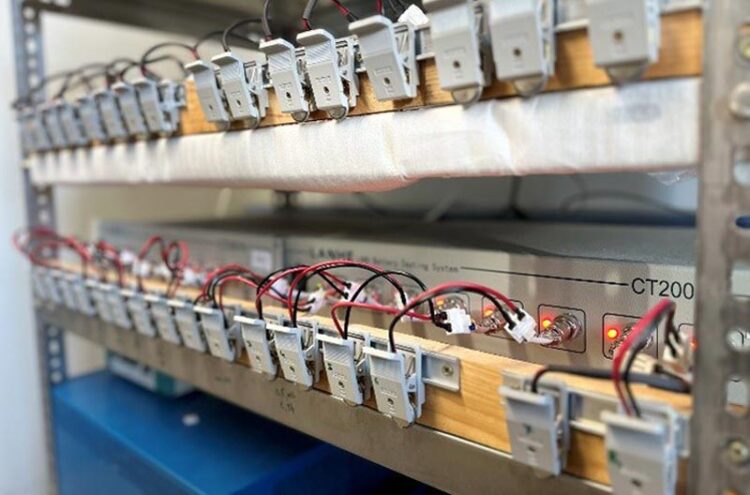Decisive breakthrough for battery production

Test track for batteries: Test setup in the laboratory of Prof. Dr. Michael J. Bojdys' research group in Berlin-Adlershof (Photo: Barbora Balcarova/Bojdys-Lab https://bojdyslab.org/)
Storing and utilising energy with innovative sulphur-based cathodes.
HU research team develops foundations for sustainable battery technology
Electric vehicles and portable electronic devices such as laptops and mobile phones are unthinkable without lithium-ion batteries. The problem: highly toxic materials such as cobalt are often used for the cathodes of these batteries, which jeopardise the environment and the health of people in the countries where they are mined. In addition, the reserves of these metals are very limited.
Sustainable and powerful with sulphur
A research team at Humboldt-Universität zu Berlin (HU) has now achieved a decisive breakthrough in battery technology. The team, led by Prof Dr Michael J. Bojdys, has developed a high-performance sulphur-based cathode. Sulphur is a sustainable alternative to the materials commonly used in lithium-ion batteries because it is less toxic and – unlike cobalt – is abundant. However, the storage capacity of batteries in which sulphur is used as a cathode material has so far declined rapidly. The researchers have now been able to solve this problem. The results of the study have been published in the renowned journal Angewandte Chemie.
“Our development paves the way for sulphur electrodes as a viable alternative to conventional metal-based cathodes. It could fundamentally change the way we store and use energy and represents an important step towards a more sustainable future,” explains Prof Bojdys.
Solving the sulphur-shuttle problem using polymer chemistry
With sulphur-based cathodes, the mobility of the sulphur has so far led to a degradation of the battery – an effect known as the sulphur-shuttle. In the newly developed solution, the sulphur is encapsulated in a special microporous polymer network so that the sulphur particles are retained. This battery technology not only increases the performance and service life of batteries but also avoids the problem of scarce resources.
Prof Dr Michael J. Bojdys is an expert in sustainable energy materials and, as part of the GreenCHEM funding initiative of the German Federal Ministry of Education and Research, is helping to transform the chemical industry in the Berlin capital region by combining science and industry to create a circular economy based on sustainable raw materials.
Further information
Research article: Guiping Li, Ye Liu, Thorsten Schultz, Moritz Exner, Ruslan Muydinov, Hui Wang, Kerstin Scheurell, Jieyang Huang, Norbert Koch, Paulina Szymoniak, Nicola Pinna, Philipp Adelhlem, Michael Janus Bojdys: One-pot Synthesis of High-capacity Sulfur Cathodes via In-situ Polymerization of a Porous Imine-based Polymer. Angew. Chem. Int. Ed. 2024, e202400382.
Link to publication: https://onlinelibrary.wiley.com/doi/10.1002/anie.202400382
Wissenschaftliche Ansprechpartner:
Prof Dr Michael J. Bojdys
Department of Chemistry of Humboldt-Universität zu Berlin
Email: michael.janus.bojdys@hu-berlin.de
Barbora Balcarova
Department of Chemistry of Humboldt-Universität zu Berlin
Media Contact
All latest news from the category: Life Sciences and Chemistry
Articles and reports from the Life Sciences and chemistry area deal with applied and basic research into modern biology, chemistry and human medicine.
Valuable information can be found on a range of life sciences fields including bacteriology, biochemistry, bionics, bioinformatics, biophysics, biotechnology, genetics, geobotany, human biology, marine biology, microbiology, molecular biology, cellular biology, zoology, bioinorganic chemistry, microchemistry and environmental chemistry.
Newest articles

Sea slugs inspire highly stretchable biomedical sensor
USC Viterbi School of Engineering researcher Hangbo Zhao presents findings on highly stretchable and customizable microneedles for application in fields including neuroscience, tissue engineering, and wearable bioelectronics. The revolution in…

Twisting and binding matter waves with photons in a cavity
Precisely measuring the energy states of individual atoms has been a historical challenge for physicists due to atomic recoil. When an atom interacts with a photon, the atom “recoils” in…

Nanotubes, nanoparticles, and antibodies detect tiny amounts of fentanyl
New sensor is six orders of magnitude more sensitive than the next best thing. A research team at Pitt led by Alexander Star, a chemistry professor in the Kenneth P. Dietrich…





















